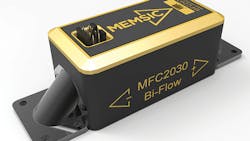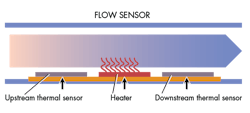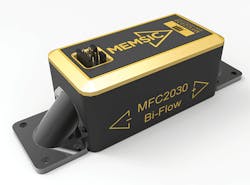Sensor Leverages Thermodynamics to Measure Gas Flows
This file type includes high-resolution graphics and schematics when applicable.
The MFC2000 series gas flow sensor from MEMSIC Inc., Andover, Mass., can measure up to 70 liters per minute of gas flow (in either direction) while creating less than a 18-mbar pressure drop.
The actual sensor consists of a small cavity integrated into CMOS circuitry equipped with a 15-mW heat source and two thermopiles, one upstream and one downstream from the heater. When gas flows through the sensor’s flow path, which is parallel to the rest of the flow, the incoming and upstream thermopile measures the gas’s temperature. The downstream thermopile detects more heat since the gas has traveled over the heater. An algorithm then calculates the flow rate using the temperature readings and timing data to determine the gas’s flow rate. Accuracy is to within 3%; repeatability is ±0.8%.
The heater’s output is a function of flow—the higher the flow, the more heat is generated. This minimizes power to the heater when flow is low or nearly zero. Other heat flow paths, such as through the substrate or electrical leads, have been minimized by designers so that they don’t upset the thermal-mass readings. The meter works on some flammable gases and has been tested with natural gas.
The lack of moving parts makes the device durable and long-lasting. It is also economical in terms of power, operating on less than 5 mA. When in sleep mode (no flow), it needs only 100 µA. It requires 2.5 to 5.5 V of external power, but typically runs on 3.3 V. The output is digital, but other types are available.



